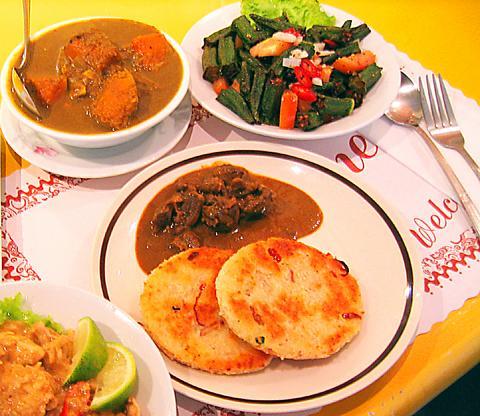Downtown-dwelling Indian curry lovers fed up to the back teeth with having to fork out thousands of NT dollars for a run-of-the-mill slap-up meal should take a trip across the "Gulf of Manner," or the Waishuang River (外雙溪) and check out the Lanka Restaurant.
Located opposite Yangming Hospital (陽明醫院), the restaurant was opened by Damian Chee (齊興盛), an overseas Chinese from Sri Lanka whose father once owned a Chinese restaurant in Colombo, 15 years ago.

PHOTO: GAVIN PHIPPS , TAIPEI TIMES
Once a hangout for illegal Sri Lankan workers until the early 1990s, when many of them were deported, the joint has built up a reputation with both locals and expats alike as one of the cheapest and tastiest authentic curry joints in town.
At the Lanka, diners can forget about the fancy trappings of many a Taipei curry eatery, as the interior is sparsely decorated and the fittings are not that far removed from your average local mom-and-pop diner. But then the Lanka, unlike the lush green mountainous country from whence its proprietor hails is not a place to enjoy vistas -- it is a place to eat.
Using two different types of curry powder -- regular and roasted -- and with the addition of differing proportions of spices such as cardamom, cumin and coriander as well as coconut milk, Sri Lankan curries are lighter than their gee- and yogurt-heavy Indian brethren.
The Lanka's menu is extensive, offering diners the choice of a selection of set meals which cost from NT$175 to NT$200, or individual dishes which cost an average of NT$150. Mildly spicy meat dishes cost NT$130 while the varied selection of vegetable curries -- -- which include spinach, potato, lentil, a tasty pumpkin and an interesting mushroom and cashew nut -- cost between NT$90 and NT$110.
For diners looking to experiment, then one of Chee's sambols, or Sri Lankan salads, makes for a refreshing way to begin any meal. Costing from NT$90 to NT$110, the zesty chili and lemon-loaded salads are available in half a dozen varieties, of which the okra comes highly recommended. Other traditional Sri Lankan treats include spiced tomato palandies (NT$230 - NT$250) and poories NT$140/60), or lightly fried bread.
Unlike Indian eateries, where the nan bread is king, at the Lanka it is the roti that supplements the meal, at NT$70 for a pair.

The Nuremberg trials have inspired filmmakers before, from Stanley Kramer’s 1961 drama to the 2000 television miniseries with Alec Baldwin and Brian Cox. But for the latest take, Nuremberg, writer-director James Vanderbilt focuses on a lesser-known figure: The US Army psychiatrist Douglas Kelley, who after the war was assigned to supervise and evaluate captured Nazi leaders to ensure they were fit for trial (and also keep them alive). But his is a name that had been largely forgotten: He wasn’t even a character in the miniseries. Kelley, portrayed in the film by Rami Malek, was an ambitious sort who saw in

It’s always a pleasure to see something one has long advocated slowly become reality. The late August visit of a delegation to the Philippines led by Deputy Minister of Agriculture Huang Chao-ching (黃昭欽), Chair of Chinese International Economic Cooperation Association Joseph Lyu (呂桔誠) and US-Taiwan Business Council vice president, Lotta Danielsson, was yet another example of how the two nations are drawing closer together. The security threat from the People’s Republic of China (PRC), along with their complementary economies, is finally fostering growth in ties. Interestingly, officials from both sides often refer to a shared Austronesian heritage when arguing for

Among the Nazis who were prosecuted during the Nuremberg trials in 1945 and 1946 was Hitler’s second-in-command, Hermann Goring. Less widely known, though, is the involvement of the US psychiatrist Douglas Kelley, who spent more than 80 hours interviewing and assessing Goring and 21 other Nazi officials prior to the trials. As described in Jack El-Hai’s 2013 book The Nazi and the Psychiatrist, Kelley was charmed by Goring but also haunted by his own conclusion that the Nazis’ atrocities were not specific to that time and place or to those people: they could in fact happen anywhere. He was ultimately

Last week gave us the droll little comedy of People’s Republic of China’s (PRC) consul general in Osaka posting a threat on X in response to Japanese Prime Minister Sanae Takaichi saying to the Diet that a Chinese attack on Taiwan may be an “existential threat” to Japan. That would allow Japanese Self Defence Forces to respond militarily. The PRC representative then said that if a “filthy neck sticks itself in uninvited, we will cut it off without a moment’s hesitation. Are you prepared for that?” This was widely, and probably deliberately, construed as a threat to behead Takaichi, though it